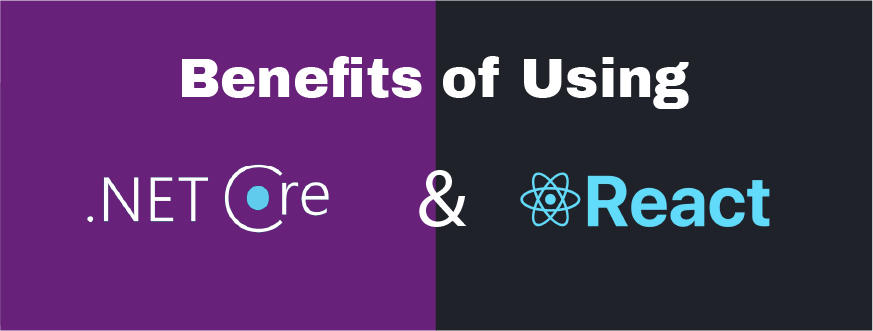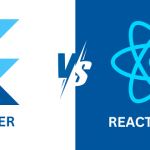For those who are extensively involved in application development, React and ASP .NET Core are not alien words. These two technologies are most commonly used for application/software developments. However, both of these aren’t 100% perfect, like any other technology.
The best a skilled developer can do to perfect the development is to bring these two together, so that best of both worlds are enjoyed in full swing.
Yes, you heard it right. Blending two or more technology for a single project is a common practice and is often the only way to expand the capabilities and functionalities of the final product.
In this post, we’ll talk about the reasons to club React and ASP .NET Core technologies and the benefits that this combination brings along with it.
React With ASP .NET Core – The Combination to Try For Sure
There are many ways to build React-based apps to complete further production. We have already seen the combination of React with Node.js or Java. The latest talk of the developer town is combining React with ASP .NET Core. Many projects are now involving these two technologies together, and developers are claiming that they are experiencing better than before capabilities.
Even though this merger puts an additional responsibility of handling the server code wherein tasks like loading of index.html page with ASP .NET Core on developers’ shoulders, the developer community is still promoting this combination, especially when the development goal is all about creating feature-rich CRA or Create React App projects.
Why is it so?
Well, here is a look at the most common benefits that one can expect by bringing React and ASP .NETC Core together:
- This combination also leads to using ASP .NET Core as a web API and CRA React as a UI. The ASP .NET Core is used for tasks like performing authorization and data access on the server-side, while React will take care of UI concerns while residing in the ClientApp subdirectory. This way, the two most crucial aspects of software/application development are taken care of together.
- By combining these two technologies, developers have the freedom to host React and ASP .NET Core projects in a unified ASP .NET Core project. There is no need to manage these two technologies from two different platforms.
- Developers can use React capabilities within a .NET Core app or vice-versa. This way, overall development time is reduced greatly, and development finishes at the right time. This matters for the most urgent projects that need to be delivered in a short time.
Besides, the combination also leads to:
-
Higher Accessibility
The project, featuring the React with ASP .NET Core, is capable to begin the CRA development server automatically in the background. The process initiates on its own when the ASP .NET Core app starts in development mode. This is convenient because it means you don’t have to run a separate server manually. This automation not only speed-up the development but also increases the server accessibility time.
-
Easy Visual Editing
If you don’t have a very skilled team of developers that using React with aspNET Core is a great option to have perfected the front and back-end of an application. React comes with a very handy and user-friendly Visual Studio template. Now, this template is designed especially for development scenarios where ASP .NET Core is handling the backend while React is at the frontend. Almost all the leading capacities and functionalities are already added. There is not much for the developer to do. So, you can start with anyone.
.NET Framework Programming Platform – The Definitive Guide
Points to Be Noted
While all these benefits are persuasive enough to club React with ASP .NET Core for a project, it’s worth noting that it’s not an every-case scenario.
You can’t use this combination for a project that involves server-side rendering or SSR.
SSR or server-side-rendering is a crucial feature that allows the app/project to deliver HTML content via a single request. It brings multiple reliefs, such as the users don’t have to wait for a while as JavaScript assets are loading.
But, while you’re using React with ASP .Net Core, SSR is not easily possible as the library that is accessible for this combination is the ReactJS.Net library which lacks features like code splitting, HMR, and SSR support.
The best alternative here is using React and Node.js with Razzle or Next.js. Both these tools promote SSR.
The default set–up that promotes auto-installation of CRA development server is not always a good thing. There is a huge drawback. For instance, whenever you modify the C# code, and the ASP .NET Core asks for a restart, the CRA server also goes through a re-start. The entire process demands a few seconds for successful completion of backup during the re-start. This can cause a certain delay. Also, it makes frequent restarts. As C# edits are very tough, frequent re-starts can lead to a crash.
Prerequisites for the Job
Before you start merging these two technologies together, understand the basic prerequisites of the task. The first one is very basic. It is: Having React and .Net Core installed on the laptop or system you’re using to design an app.
In addition, it’s imperative to have a deeper understanding of HTTP. Also, the laptop/system should have.NET SDK, VSCode, Create React App, and react-bootstrap.
For effective utilization of these two technologies, it’s very crucial to find out whether the existing versions of these two technologies are compatible with each other.
To check the version details, use the ‘dotnet-version’ command.
In Conclusion
Creating a wonderful app demands merger of two or more wonderful technologies. When handled by expert developers, React, and ASP .NET Core are merged, and useful CRA and other developments are bound to happen. However, the job isn’t as simple as it seems.
It demands a deeper understanding of both the technologies and best use cases, which is not everyone’s cup of tea. The best way to bring benefits of React with ASP .NET Core together is to hire full stack software development company that has explored these two technologies extensively.
C-Metric, a leading software development company, has in-house skilled React and ASP .NET Core full stack developers that will help you reap the maximum benefits of these technologies. Many projects featuring these two technologies have already been delivered with full perfection. Contact us and let their expertise work for your betterment while you enjoy the aid of an advanced software application.















Get in Touch